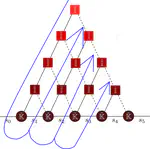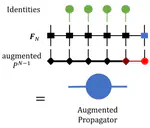Tensor Network Path Integral
 Different tensor networks can be used to manifestly capture different properties of the dynamics.
Different tensor networks can be used to manifestly capture different properties of the dynamics.
Simulations of real-time dynamics of quantum systems coupled with dissipative media is plagued by the curse of dimensionality. As a way to avoid the problem, many methods integrate out the bath and simulate the dynamics of the reduced density matrix. Such simulations are characterized by the presence of non-Markovian memory. Path integrals, through the use of Feynman-Vernon’s influence functional, provides a rigorous way of capturing this non-Markovian effect of the environment on the system.
The most challenging aspect is that the cost of these calculations grow exponentially with the memory length. We classify approaches that utilize tensor networks to make path integral simulations more efficient as belonging to the tensor network path integral (TNPI) family of methods. There can be many different kinds of tensor networks that are used. Time-evolved matrix product operators (TEMPO) is a particular one that uses matrix product states and matrix product operators for simulating real-time dynamics with Feynman-Vernon influence functional. We have developed a method called the pairwise-connected tensor network path integral (PC-TNPI) as a generalization on these approaches. Additionally, the TNPI framework allows for further factorization of the system to deal with extended systems. This extension, called the multisite tensor network path integral (MS-TNPI), is described in its own section.



